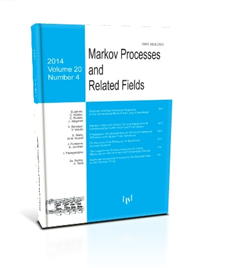The Allelic Partition for Coalescent Point Processes
A. Lambert
2009, v.15, Issue 3, 359-386
ABSTRACT
Assume that individuals alive at time $t$ in some population can be ranked in such a way that the coalescence times between consecutive individuals are i.i.d. The ranked sequence of these branches is called a coalescent point process. We have shown in a previous work that splitting trees are important instances of such populations. Here, individuals are given DNA sequences, and for a sample of $n$ DNA sequences belonging to distinct individuals, we consider the number $S_n$ of polymorphic sites (sites at which at least two sequences differ), and the number $A_n$ of distinct haplotypes (sequences differing at one site at least). It is standard to assume that mutations arrive at constant rate (on germ lines), and never hit the same site on the DNA sequence. We study the mutation pattern associated with coalescent point processes under this assumption. Here, $S_n$ and $A_n$ grow linearly as $n$ grows, with explicit rate. However, when the branch lengths have infinite expectation, $S_n$ grows more rapidly, e.g. as $n \ln(n)$ for critical birth-death processes. Then, we study the frequency spectrum of the sample, that is, the numbers of polymorphic sites/haplotypes carried by $k$ individuals in the sample. These numbers are shown to grow also linearly with sample size, and we provide simple explicit formulae for mutation frequencies and haplotype frequencies. For critical birth-death processes, mutation frequencies are given by the harmonic series and haplotype frequencies by Fisher's logarithmic series.
Keywords: coalescent point process,splitting tree,Crump - Mode - Jagersprocess,linear birth,death process,Yule process,allelic partition,infinite site model,infinite allele model,Poisson point process,Levy process,scale function,law of large numbers,Kingman coalescent,Fisher logarithmic series
COMMENTS
Please log in or register to leave a comment

